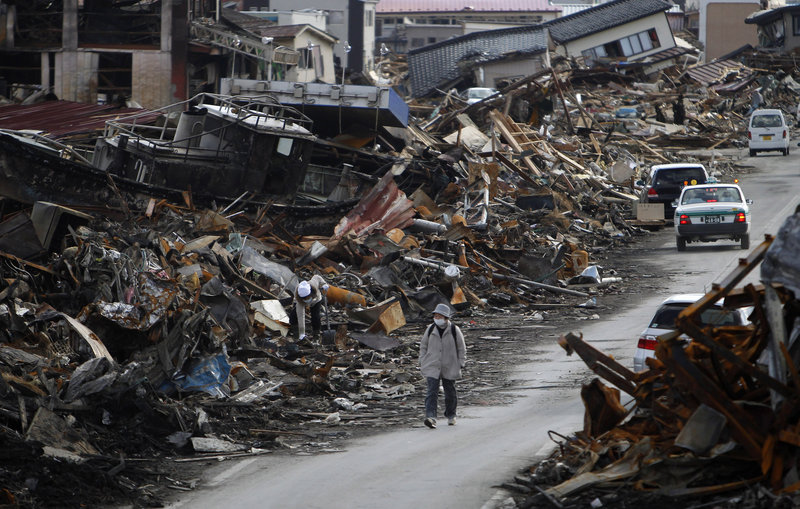Nearly two weeks of rolling blackouts, distribution problems and contamination fears prompted by a leaking, tsunami-damaged nuclear plant have left shelves stripped bare of some basic necessities in stores across Tokyo. Some people are even turning to the city’s ubiquitous vending machines to find increasingly scarce bottles of water.
At the source of the anxiety — the overheated, radiation-leaking nuclear plant — there was yet another setback Thursday as two workers were injured when they stepped into radiation-contaminated water. The two were treated at a hospital.
Supplies of bottled water grew scarce in Tokyo, one day after city officials warned that the level of radioactive iodine in the tap water was more than twice what is considered safe for babies to drink. Tests conducted Thursday showed the levels in the city’s water fell to acceptable limits for infants, but they were up in neighboring regions.
Frightened Tokyo residents hoping to stock up on bottled water and other goods flocked to shops across the city, some of which tried to prevent hoarding by imposing buying limits.
“The first thought was that I need to buy bottles of water,” said Reiko Matsumoto, a real estate agent and mother of a 5-year-old, who rushed to a nearby store to stock up on supplies. “I also don’t know whether I can let her take a bath.”
The shortages were mainly limited to basic staples, such as rice, instant noodles and milk. Vegetables, meat and tofu, meanwhile, were readily available in most places.
Japan has been grappling with an avalanche of miseries that began with a massive, 9.0-magnitude earthquake on March 11. That triggered a violent tsunami, which ravaged the northeast coast, killed an estimated 18,000 people and left hundreds of thousands homeless. The quake and tsunami also damaged the critical cooling system at the Fukushima Dai-ichi plant, which overheated and began spewing radiation into the environment.
Workers have been struggling to get the cooling system operating again, but their efforts have been hampered by explosions, fires and radiation scares. Lighting was restored Thursday to the central control room at Unit 1 for the first time since the quake and tsunami.
But two workers were hospitalized after stepping into contaminated water while laying electrical cables in one unit, nuclear and government officials said. The water seeped over the top of their boots and onto their legs, said Takashi Kurita, spokesman for plant owner Tokyo Electric Power Co.
The two likely suffered “beta ray burns,” Tokyo Electric said, citing doctors. They tested at radiation levels between 170 to 180 millisieverts, well below the maximum 250 millisieverts allowed for workers, said Fumio Matsuda, a spokesman for the Nuclear and Industrial Safety Agency.
The men will be transferred to a radiology medical institute Friday, said Hidehiko Nishiyama, another nuclear agency spokesman. Their injuries were not life-threatening.
More than two dozen people have been injured trying to bring the plant, located 140 miles (220 kilometers) northeast of Tokyo, under control.
The death toll from the earthquake and tsunami continued to rise, meanwhile, with more than 9,800 bodies counted and more than 17,500 people listed as missing. Those tallies may overlap, but police from one of the hardest-hit prefectures, Miyagi, estimate that the deaths will top 15,000 in that region alone.
The crisis has stoked fears about the safety of Japan’s food and water supply. Radiation has been found in raw milk, seawater and 11 kinds of vegetables, including broccoli, cauliflower and turnips, grown in areas around the plant.
The U.S. and Australia halted imports of Japanese dairy and produce from the region, Hong Kong said it would require that Japan perform safety checks on meat, eggs and seafood, and Canada said it would upgrade controls on imports of Japanese food products. Singapore, too, has banned the sale of milk, produce, meat and seafood from areas near the plant.
Concerns also spread to Europe. In Iceland, officials said they measured trace amounts of radioactive iodine in the air but assured residents it was “less than a millionth” of levels found in Europe in the wake of the 1986 Chernobyl disaster – the world’s worst nuclear accident.
Radioactive iodine is short-lived, with a half-life of eight days – the length of time it takes for half of it to break down harmlessly. However, experts say infants are particularly vulnerable to radioactive iodine.
In Tokyo, government spokesman Yukio Edano pleaded for calm over the water contamination, and said the government was considering importing bottled water from other countries to cover any shortages. Officials urged residents to avoid panicked stockpiling and the city began distributing 240,000 bottles – enough to give each of the 80,000 children under age 1 three small bottles of water.
Worse hardships continued in the frigid, tsunami-struck northeast. Some 660,000 households still do not have water, the government said.
Copy the Story Link
Send questions/comments to the editors.



Success. Please wait for the page to reload. If the page does not reload within 5 seconds, please refresh the page.
Enter your email and password to access comments.
Hi, to comment on stories you must . This profile is in addition to your subscription and website login.
Already have a commenting profile? .
Invalid username/password.
Please check your email to confirm and complete your registration.
Only subscribers are eligible to post comments. Please subscribe or login first for digital access. Here’s why.
Use the form below to reset your password. When you've submitted your account email, we will send an email with a reset code.